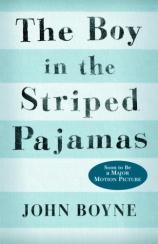Reading Group Guide
Discussion Questions
The Boy in the Striped Pajamas

1. Discuss the relationship between Bruno and Gretel. Why does Bruno seem younger than nine? In a traditional fable, characters are usually one-sided. How might Bruno and Gretel be considered one-dimensional?
2. At age 12, Gretel is the proper age for membership in the League of Young Girls, a branch of Hitler’s Youth Organization. Why do you think she is not a member, especially since her father is a high-ranking officer in Hitler's army?
3. What is it about the house at Out-With that makes Bruno feel “cold and unsafe”? How is this feeling perpetuated as he encounters people like Pavel, Maria, Lt. Kotler, and Shmuel?
4. Describe his reaction when he first sees the people in the striped pajamas. What does Gretel mean when she says, “Something about the way [Bruno] was watching made her feel suddenly nervous”? (p. 28) How does this statement foreshadow Bruno’s ultimate demise?
5. Bruno asks his father about the people outside their house at Auschwitz. His father answers, “They’re not people at all Bruno.” (p. 53) Discuss the horror of this attitude. How does his father’s statement make Bruno more curious about Out-With?
6. Explain what Bruno’s mother means when she says, “We don’t have the luxury of thinking.” (p. 13) Identify scenes from the novel that Bruno’s mother isn’t happy about their life at Out-With. Debate whether she is unhappy being away from Berlin, or whether she is angry about her husband’s position. How does Bruno’s grandmother react to her son’s military role?
7. When Bruno and his family board the train for Auschwitz, he notices an over-crowded train headed in the same direction. How does he later make the connection between Shmuel and that train? How are both trains symbolic of each boy’s final journey?
8. Bruno issues a protest about leaving Berlin. His father responds, “Do you think that I would have made such a success of my life if I hadn’t learned when to argue and when to keep my mouth shut and follow orders?” (p. 49) What question might Bruno’s father ask at the end of the novel?
9. A pun is most often seen as humorous. But, in this novel the narrator uses dark or solemn puns like Out-With and Fury to convey certain meanings. Bruno is simply mispronouncing the real words, but the author is clearly asking the reader to consider a double meaning to these words. Discuss the use of this wordplay as a literary device. What is the narrator trying to convey to the reader? How do these words further communicate the horror of the situation?
10. When Bruno dresses in the filthy striped pajamas, he remembers something his grandmother once said. “You wear the right outfit and you feel like the person you’re pretending to be.” (p, 205) How is this true for Bruno? What about his father? What does this statement contribute to the overall meaning of the story?
11. Discuss the moral or message of the novel. What new insights and understandings does John Boyne want the reader to gain from reading this story?
12. Ask students to discuss the differences in a fable, an allegory, and a proverb. How might this story fit into each genre?
The Boy in the Striped Pajamas
- Publication Date: October 23, 2007
- Genres: Fiction, Historical Fiction, Holocaust
- Paperback: 240 pages
- Publisher: Ember
- ISBN-10: 0385751532
- ISBN-13: 9780385751537








